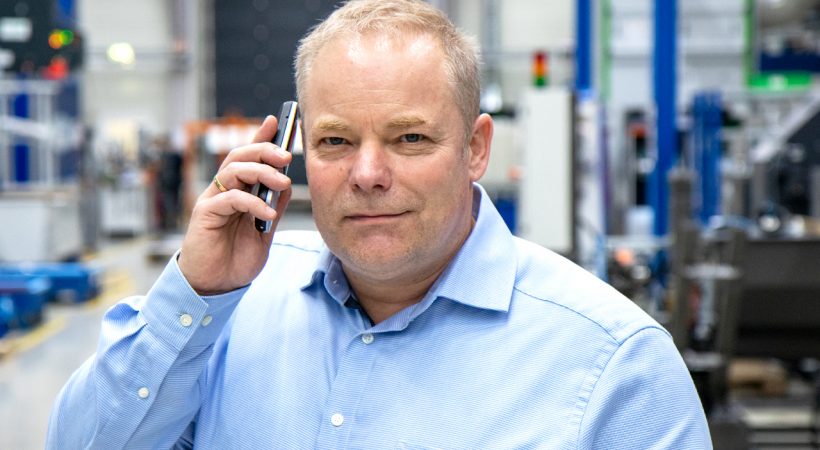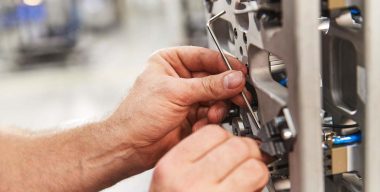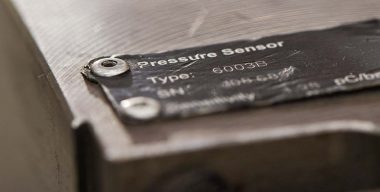
Thermoset injection mould
Overmoulding of circuit boards
Thermosets are the right material for a “case of hardship”* – especially if electronic components require overmoulding. For such a case, we designed and built the appropriate injection moulding tool: In a partnership initiative, a joint project was successfully implemented to overmould a printed circuit board.
*Case of Hardship
Thermosets are often used for harsh applications in which mechanical stiffness, abrasion resistance, thermal or electrical loads set special requirements for the plastic.


Thermoset injection mould – free of burrs
The processing of a thermoset also places demands on the mould technology: in contrast to classic injection moulding, the mould must be operated at a much higher temperature in order for the plastic to react within the mould. In addition, the material forms burrs extremely easily thus the mould has to be manufactured and spotted very precisely.
In order for this process to succeed, Hofmann manufactured a corresponding mould for the joint project with all these factors in mind. The result: a burr-free end product!
During the fully automated manufacturing process, the circuit boards are cleaned and pre-treated using plasma to ensure adhesion between the thermoset and the circuit board. A robot inserts the cleaned circuit board into our mould, in which our mould positions the circuit board together with the handling. The Arburg Allrounder is used overmould the board in our injection mould, protecting it for later use.

What is thermoset?
This material is a polymer that belongs to the so-called duromer plastics. Unlike thermoplastics, which melt when heated and can be moulded repeatedly, a thermoset hardens after initial curing and retains its final shape.
Benefits of thermosets
- High mechanical strength: Thermosets generally have excellent mechanical strength, which makes them suitable for applications that require strength and stability.
- High temperature resistance: The material is usually heat-resistant and can withstand higher temperatures without melting or deforming.
- Good chemical resistance: Thermosets are resistant to many chemical substances, which makes them suitable for use in environments with aggressive chemicals.
- Electrical insulation properties: They often have good electrical insulation properties and are therefore used in electrical applications.
- Low moisture absorption: They generally absorb little moisture, which makes them suitable for applications in humid environments.
The material is used for the automotive and electrical industries, aviation, household appliances and sporting goods, among others.


Electrical components and thermoset
Overmoulding electrical components with thermoset in the injection mould offers advantages not only in terms of the end product, but also regarding to the injection moulding process itself:
- Reduction of assembly and connection effort: By overmoulding electrical components in the injection mould, several separate parts or connecting elements can be avoided. This simplifies assembly and reduces the number of connection points required, saving time and costs.
- Cost reduction: Because overmoulding can often be done in a single step, rather than manufacturing multiple parts and assembling them later, there are cost savings in terms of labour costs and material consumption.
- Improved consistency and quality: Overmoulding allows better control over the process as it takes place in a closed environment. This results in higher consistency and quality of the overmoulded components.
- Shorter production cycles: Overmoulding in an injection moulding tool can shorten production cycles as it is an efficient method of mass manufacturing electrical components.
- Simple integration into mass production: Overmoulding of electrical components in the injection mould is well suited to be integrated into mass production processes. This is particularly advantageous in automotive and electronics industries.
- Waste reduction:Since the components are overmoulded directly in the mould without separate housings or assembly processes, there is less waste in the form of scrap or waste material.
- Reduction of disturbances due to external influences: Overmoulding can help to protect electrical components from external influences such as vibration, moisture and dust. This increases the reliability and service life of the components.
- Freedom of design: Overmoulding allows greater design freedom, as the components can be moulded directly into the desired shape. This simplifies the integration of electrical components into complex assemblies and devices.


Special features of thermoset moulds
Our experienced designers and toolmakers know what is important for this type of mould. To ensure that the project mould achieves the best possible quality, special attention was paid to the following points, as with any other thermoset project:
- High temperature resistance: When designing the injection mould for thermosets, care must be taken to ensure that the mould components are made of high temperature resistant materials that can withstand the high curing temperatures of the material. This requires the use of tool steels or alloys that retain their strength and dimensional stability at high temperatures. With 65 years of experience in mould making, Hofmann knows exactly which materials are perfectly suited.
- Dimensional accuracy: Precision is crucial. The tool geometry must be carefully designed to ensure the desired shapes and dimensions of the final product. This requires precise dimensioning and a high surface quality of the tool cavities. Our automated production lines enable us to meet these requirements in the best way possible.
- Pressure and heat resistance: The mould components must be designed to withstand the high pressures and temperatures of the injection process. This requires the use of tool steels and alloys which are both heat and wear resistant. In addition, the moulds must have efficient cooling to control temperatures during injection moulding. With detailed simulations before the mould manufacturing, we determine the best cooling for your mould as well.
- High wear resistance: Due to the abrasive nature of thermosets, special surface treatment or coating of the tool surfaces are required to minimise wear. This can be achieved, for example, by nitriding, hardening or the use of anti-wear coatings. Again, based on our experience, we know which option is the best solution for your project.

Your contact for thermosets
Christian Richardt
Technical Sales Director - Customer Projects
T: +49 9571 766-9660
sales@hofmann-impulsgeber.de

